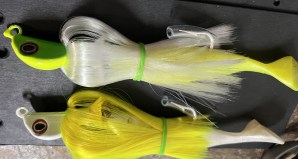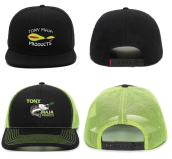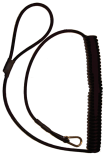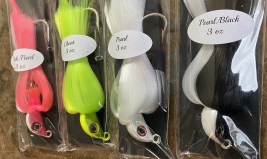Tips & Editorials
Tips & Techniques
(Spooning) TROLLING WITH WIRE LINE (SOME IDEAS)
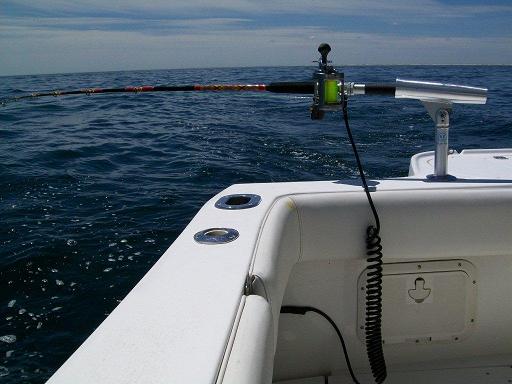 For many years using bunker spoons was always a successful way to catch the larger stripers, yet not many anglers were using this method until recently. Now with the presence of massive schools of bunker, spooning has been reborn.
For many years using bunker spoons was always a successful way to catch the larger stripers, yet not many anglers were using this method until recently. Now with the presence of massive schools of bunker, spooning has been reborn.
This type of fishing changed for me a few years ago, when I observed a wounded bunker swimming outside the school he was once part of. As he was swimming more slowly and not as erratic as the rest, a huge striper came and engulfed him. That’s when I realized I had it all wrong. This is when I tweaked my home made spoons to swim more subtle. They now have a two foot sweep rather than a four foot sweep. My hook up and catch rate nearly doubled with this new find and the rest is history.
Spooning is a fairly easy style of fishing if you have the right tools. First you must have the right spoon. Many on the market will work but some better than others. My spoons work right out of the package and are made of heavy stainless steel and won’t bend after catching larger fish. The action will still be the same fish after fish.
Next you need the right rod to get your spoon to work at its maximum potential. I just started to manufacture such a rod to make this happen. This custom rod is made for bunker spoons exclusively. Although you can purchase a store bought rod, I strongly recommend a custom rod for better performance and durability.
Now you need a good reel. There are a few I would recommend. My first choice is the Canyon Tony Maja Signature Series this reel has a lever drag(Which I prefer when trolling) and has a 40lb drag 6 to one retrieve and will hold 300’ of 40lb wire with 200’ of 50lb mono backing it is a more compact and lighter than the reels most commonly used . Other reels are the Shimano TLD series the 20 or the 25 or a Penn 113H or the 6/0. I use 40# monel wire. It’s more forgiving than stainless. For backing, I then put 50# mono and 15’of 60# mono leader.
Next you need a set of out rodders to make it easier to get the rod out of the holder with a fish on the end of your line. This is no easy task if your outrodder is in a fixed horizontal position. I designed the E-Z Outrodder that lifts to a vertical position to correct this problem.
Okay, now you have the right tackle. It’s time for technique. Whether you’re using wire, braid, or mono you must know what dept your spoon is swimming at. I use wire exclusively and with spoons that weigh 6-12 ounces they will swim down 10’ for every 100’ of wire. Spoons that weigh 13-16 ounces will swim down 40’. This may vary with wind and current. Braid and mono is another story. I can’t seem to get the same formula no matter who I speak to. Next is speed. This is when you have to pay attention to the tip of your spoon rod. It should have a steady pulsation or pumping action, and can range from two to four knots depending on conditions. Time and season is very important. In the spring, at first light I will fish in shallower water and when the sun reaches a certain level, (usually by 8am) I fish the deep, bass are very light sensitive. In the fall you can fish almost any time of the day because of the angle of the sun.
What size spoon should I use? This is one of the most asked question I get. This past spring was a good example. I was marking a lot of bait and had my larger spoons out to no avail,I then used one of my smaller ones and hit the jackpot. After catching and releasing 7 bass from 26-42lbs, I gutted a smaller one and found small herring and butterfish. So my advice would be try different sizes until you hit it right.
Next most asked question is what dept should my spoons swim . This is where I said you must know where your spoon is at all times. Rule of thumb for me is that I like to swim my spoon 5’ under the bait and 10’ off structure. When using two or more rods keep them at different depts, until you catch. Another asked question is what direction is best for spoons. From my experience cross current is the best and with the current next. Unfortunately this is a problem when there is a lot of boats trolling, they mostly go north and south. If you are catching in an area and only hooking up going in one direction, I would then pick up my lines and go back and start all over. This is where GPS is essential.
Last is using weights. I never use a drail sinker when there are bluefish around, I lost too many spoons that way when Mr. Bluefish thought my drail was bait. I instead use two barrel swivels, one attaching my wire to a 15’ leader and the other sliding from my wire to the other swivel(like A fish finder rig) and attach 4’ of 60# braid to a bank sinker( every 6oz brings it down approx. 4-8’)
I hope this will help you better understand spooning, this technique has caught more and larger striped bass for me in the past forty years.


